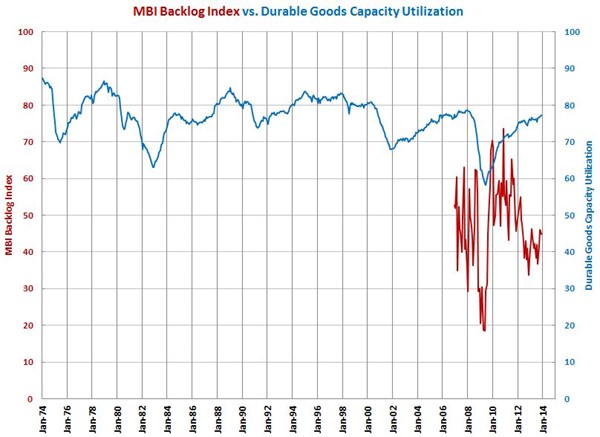Capacity Utilization Rises to 77.3%
This is the highest level of capacity utilization since March 2008. November's capacity utilization was 2.0% higher than it was in November 2012.
According to the Federal Reserve, durable goods capacity utilization was 77.3% in November 2013. This is the highest level of capacity utilization since March 2008. November's capacity utilization was 2.0% higher than it was in November 2012. This is the fourth straight month that the month-over-month rate of change has grown. Also, those four months represent the fastest rate of growth in capacity utilization in 2013. During those four months, the annual rate of change has been eseentially flat at 1.5%. However, with the faster growth in the monthly numbers, the annual rate of change should show accelerating growth soon. As the number leading indicator of capital equipment spending, the trend in durable goods capacity utilization is pointing towards a strong 2014 for capital equipment sales.
Forecasting capacity utilization can be difficult because it is dependent on existing capacity, new orders, new capacity, and productivity improvements as well as other variables. However, the backlog index from our metalworking business index looks to be an excellent leading indicator for durable goods capacity utilization. It appears that our backlog index leads durable goods capacity utilization by six months on average. Our backlog index has contracting at a slower rate since April 2013. This indicates that capacity utilization should see accelerating growth in the next couple of months.
In order for the annual rate of change in durable goods capacity to reflect the current trend in the annual rate of change of our backlog index, actual capacity utilization would need to reach roughly 80% or a little more by the end of 2014. If this happens, capacity utilization would be reach its highest level in more than a decade and would signal a very strong capital equipment market.
We use capacity utilization as a leading indicator for a number of industries, although it is not tracked for as many industries as industrial production. You can see the trends in capacity utilization for a number of industries below.
Accelerating Growth: construction materials; furniture; primary metals; printing; wood and paper
Decelerating Growth: aerospace; automotive; custom processors; durable goods; food and beverage processing; forming and fabricating (non-auto); plastics and rubber; textiles, clothing and leather goods
Accelerating Contraction: electronics, computers, and telecommunications
Decelerating Contraction: machinery and equipment; petrochemical processors




.JPG;width=70;height=70;mode=crop)